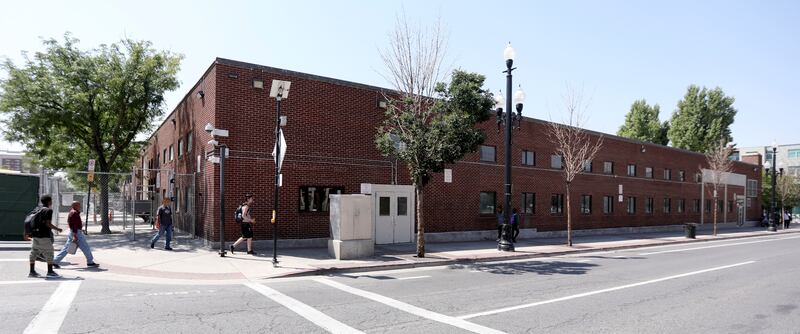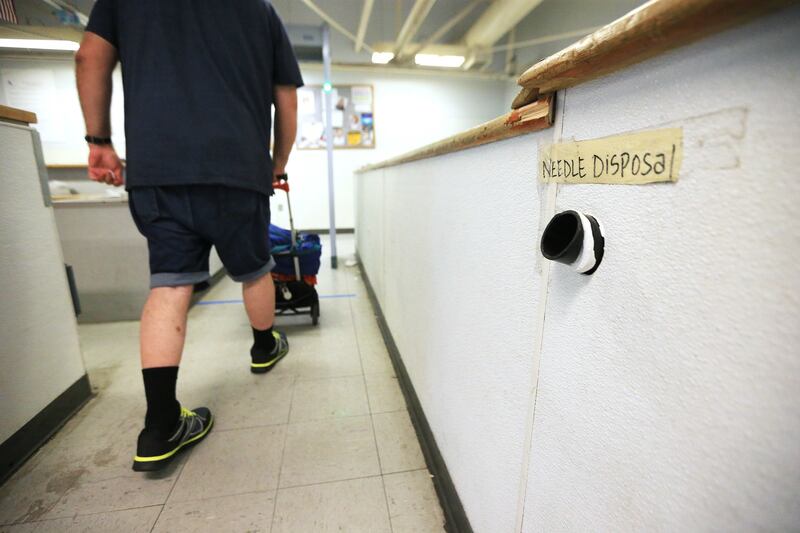SALT LAKE CITY — Last fall, the Road Home got a new landlord when the state bought the downtown shelter not long after a concerning state audit found lax security and widespread drug use within its downtown shelter.
Since then, the Road Home — which is slated to operate the largest, 300-bed men's homeless resource center in South Salt Lake expected to open later this year — was supposed to implement new security policies to address that legislative audit.
But a recent internal audit conducted by the state's Department of Workforce Services shows the Road Home was still inconsistently following its own new safety and security plan — though more recent reports indicate it has made more progress.
Auditors viewed security footage and found Road Home staffers inconsistently screened clients during the check-in process and custodians were not reporting drug paraphernalia found during cleaning.

The internal audit — sent out to media outlets earlier this week for a press event highlighting crime improvements in The Gateway and Rio Grande area — was conducted from November to January, about five months after the Road Home launched its new security plan.
And yet, while auditors found safety, security and sanitation issues at the downtown shelter have appeared to improve, Road Home incident reports from September through November reported 82 instances of drugs or needles and 10 weapons not discovered during the check-in process that were later found in the shelter, according to the report.
Additionally, auditors found dozens of instances when the Road Home's new safety and security policies and procedures were not being followed, the report states.
According to December security footage, out of 100 women and 100 men checking into the downtown shelter, 162 check-ins did not follow procedures, auditors wrote. That included 60 individuals who did not empty their pockets during the screening process, 26 who did not remove their outerwear for inspection, 58 clients whose clothing was not inspected, and five who walked through without any inspection at all, auditors wrote.
Out of 120 people entering the shelter with bags, 119 did not empty the contents of their bags for screening, and 10 of those bags weren't inspected at all. Plus, out of 47 times when the metal detector was set off, security did not pat down or wand 33 people, auditors wrote.
Auditors also found that Kane Security, the private security firm hired by the Road Home, did not have the required two officers staffing the men's entrance of the Road Home as outlined in the security plan, and staff and security rounds were not conducted as frequently as required, either.
The Road Home also had not hired full-time restroom attendants as required by the plan, the restrooms were not cleaned as frequently as outlined in the plan, and shelter staff did not wear identifying uniforms as required by the plan, according to auditors.
Auditors made recommendations to Road Home officials to address each of the procedural shortfalls, and Matt Minkevitch, the Road Home's executive director, wrote responses agreeing to each recommendation and provided details of actions taken to address concerns.
"This is a very active, ongoing process of continuous improvement," Minkevitch told the Deseret News on Thursday.
Asked about the internal audit, Nate McDonald, spokesman for the Department of Workforce Services, said auditors have conducted two other follow-up audits to track the Road Home's progress, and many concerns outlined in the initial internal audit have shown improvement.
"We commend the Road Home for reacting quickly to the audit and establishing the safety plan," McDonald said. "What we're doing is helping them improve."
A report detailing a "follow-up review" of the downtown shelter, provided to the Deseret News Thursday, showed a "general downward trend" of bag check and check-in inspection errors when auditors checked security cameras again on Feb. 6.
Auditors also reported a trend showing improvement of security rounds and cleaning of the men's restrooms, as well as custodians now properly reporting drugs and drug paraphernalia during eight days in February.
However, the exit door to the men's lobby showed residents were continuing to bypass security screenings and improperly entering the dorm room.
McDonald said another follow-up review had been completed, but the report hadn't yet been finalized or released as of Thursday.
"We're seeing improvements," he said, crediting the Road Home for working with auditors.
The aim of the internal audits, McDonald said, is to fine-tune and learn from the Road Home's operations so Shelter the Homeless, the owner of the homeless resource centers now under construction, can ensure "best practices" when the facilities open.
"We're learning what works and what doesn't work and where we need to make improvements, but also helping residents get used to that environment and help them see the benefits of having stronger security and better cleanliness practices," McDonald said. "We hope these things stick as we move into the new homeless resource centers."
Minkevitch said he is "encouraged by the positive trajectory of our progress," crediting state leaders, Shelter the Homeless, other homeless providers, private security and law enforcement for their "collaboration."
"The notion that low barrier shelter means 'anything goes' is an unfortunate misconception," Minkevitch said. "Our thoughtful collaboration is providing a and treatment access to shelter, and most importantly, access to mental health and treatment services."


